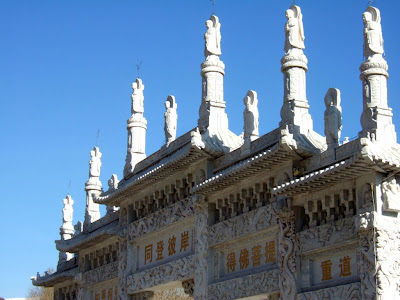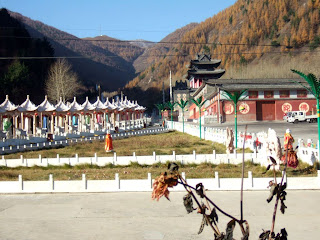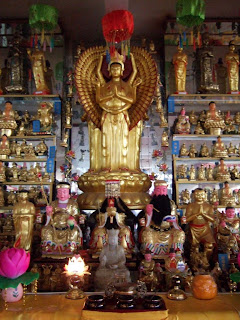
Temple Baiyun-si (白云寺) lying at the same location as the Natural mystery cave of Fomu-tong (佛母洞) at the foot of Southern Peak of Wutaishan, was established in Tang Dynasty (618-907). It was then one of the four reputed ancient monasteries in Wutaishan. The 17 meter high image of thousand hands and eyes Bodhisattva Avalokitesvara (Guanyin) and the huge sculptures of Arahats enshrined in the Main Hall were famous throughout the country. At those days, it was an essential site for homage to those great masters, monks, worthies and Buddhist devotees. Its extensive scheme and imposing site had made it a hermits cell of the region in Ming Dynasty (1368-1644) and a traveling lodge for Emperors of Qing Dynasty (1644-1911). Baiyun-si had a continuation of its glorious period for several generations and dynasties. In year 1748 during the reign of Emperor Qianglong of Qing Dynasty, the temple was burnt down by a big fire which was non-stop burning for more than half month. Followed by the fire, the temple site also faced threat from other natural disasters and seriously damaged during war and China's cultural revolution. Finally the few structures remained behind were only few pieces of broken Stele, dilapidated Hall of Dragon Kings and Dinning Halls. Restoration of Baiyun-si was a great task. In order to recover its glory of the past history, its Abbot Rev. Changlong (昌隆法师) made a great vow and worked hard for it. Under her lead and with supports from local and abroad Buddhist devotees, several building structures like the present Hall of Maha Vihara that enshrines a 5 meter high brass statue of Buddha, the Pure-land rebirth Hall, Lokapala Hall, Dizang Hall, Medicine Buddha Hall, Drum and Bell Tower, The Arch Gate, Pavilions for Bodhisattva, and Lotus Terrace for Goddess of Mercy, have been successfully completed within the past 15 years (1997-2012).


Baiyun-si was built by a government official from Taiyuan known as Daotai (道台)during Tang Dynasty (618-907). Daotai's mother had been seriously sick and could not be recovered for long time. He had been looking around for medicine or method to cure his mother. One day he met a monk who told him that his mother was dying soon. He sensed that since the monk knew his mother's condition, he must know a way to cure his mother. He begged the monk to go to his house and see his mother and incredibly, the monk just used his hands to do some actions over his mother, his mother soon recovered. Daotai asked details from the monk who only replied that he was a monk from Baiyun-si of Wutaishan and left. In deep appreciation for what the monk did, Daotai shortly traveled to Wutaishan to look for him. He looked for every where and searched all corners but could not find a temple named Baiyun-si. He was so depressed and sad but at this moment he caught hold of a thick white cloud appearing in the shape of lotus floating over his head. He looked up and saw Bodhisattva Manjushri riding a lion seated on the cloud. Manjushri gave him a smile and he immediately came to an understanding the monk was Bodhisattva Manjushri. Temple Baiyun-si was under his feet and he was assigned to build the temple. Full of bliss, Daotai thus organized and built this ancient temple to the largest scheme with no competition from any other temples in Wutaishan.


Temple Baiyun-si had several great masters during its continuation of glory within many generations and dynasties. In Song Dynasty, it had the reputable Great Master Beifeng (北风大师) as its Abbot. Strict rules and regulations were applied in temples that were under his control. The Buddhism teachings and practices were then the most orthodox and authentic. This was the time when Baiyun-si reached its peak in prosperity and fame.



Baiyun-si is the only temple site that practice Pure-land Buddhism. They emphasized on one sutra named The Teaching of Infinite Life (无量寿经) and focus on recitation of Buddha's name. There was a time that the temple organized a three years extensive retreat for the monks and nuns in the Pure-land Three Sages Hall where they recite the Buddha's time day and night for 6 hours continued for three years. And the extensive meditation courses for devotees are set in the Main Shrine Hall.


The Majestic Arch gate and Elegant Bodhisattva Pavilions shine under The Southern Terrace of Wutaishan.



Each Bodhisattva Pavilion enshrines a Bodhisattva.


Rear view of Bodhisattva Pavilions.



Bodhisattva Pavilions


The main halls were closed so we had sufficient time to bow to each and every Bodhisattva enshrined in this little elegant Pavilion.



Bodhisattva Pavilions



The little pond at Guanyin Terrace freeze into ice though it was only in the month of October.



Bowing to the huge statue of Guanyin (Goddess of Mercy).



The architectural design of the newly building structures that occupied a total land of 5ooo sq. meter at the site, followed the style of Tang Dynasty. The three main Halls constructed on the central axis are Lokapala Hall, Main Shrine Hall, Pure-land Three Sages Hall.



A simple indicative plan of newly built Baiyuan-si temple site.



It was closed for retreat when we were there. We missed the chance to pay homage to its 5 meter high brass Buddha Statue in the Main Hall.


Displayed outside the entrance gate are a standing statue of Bodhisattva Weituo, a huge carved stone lion and some drawing of Deva on the wall.


The road lead to The Cave of Fomu-tong (佛母洞) where a statue of Buddha Sakyamuni was enshrined. Many believed that whoever went in and out of the cave, he or she would be blessed and distanced from all evils and all their iniquities would be swept away, body would be cleansed from sins. We were not very sure about the condition and distance leading to the site, and how long we would have to take to climb up its thousands of stone steps, we gave up the visit.



Large number of peony inside Pureland Rebirth Hall in preparation for the coming assembly.


Baiyun-si is the only temple in Wutaishan that practice Pure-Land Buddhism.



All Halls were shut down to prepare for winter retreat. Thank you to the Dharma worker who got permission from the nun and allow us to visit this hall.



Multiple Buddha images behind the altar of Pure-land Rebirth Hall.



Figures of the 24 heavenly gods are among the images of Bodhisattva.



Baiyun-si is nested amidst a scenic sight of the beautiful southern ranges.


Magnificent view of Southern Terrace.



The view of ranges under the golden beams of afternoon sun opposite Temple Zhenhai-si (镇海寺) was amazing. The Tibetan Temple was quite popular due to two important persons that closely related to it. One was Emperor Xunzhi (顺治皇帝) of Qing Dynasty who left home to Wutaishan to become a monk after his beloved wife Princess Dong-E (董鄂妃) died. The Emperor was suspected to be in Zhenhai-si (镇海寺). The other one was The Zhangjia Third Re-incarnated Lama (章嘉活佛三世) who was the classmate and good friend to Emperor Qianlong. Zhangjia was appointed Abbot of Zhenhai-si under the order of royal family and during his assignment, he worked hard to contribute his effort in the development of Buddhism in Wutaishan. After he passed away in year 1786, Emperor Qianlong used 7000 ounces of pure gold to make a golden stupa decorated with precious stone and jewel to bury him and placed it in a secret grotto. And in memory of him, another Stupa was erected at Yongle-yuan (永乐院) at southern part of Zhenhai-si temple site.


Zhenhai-si was built at the mouth of a rocky mountain 1600 meter above sea level and about 10km away south of Town Taihuai-zhen. It sits at the mid way of the mountain and surrounded by scenic sights of pine trees and wild plants. There is a spring flowing near the site named as Undersea Spring (海底泉) which according to legend, it was the eyes of the sea. It was said that the 9th son of Dragon King busy in love with a common girl and let the water overflow and flooded the area. Bodhisattva Manjushri when came to know the incident, dropped down a large wok to repress it. The temple built at the site in Qing Dynasty (1644-1911) was thus named as Zhenhai-si meaning repress the sea. It was quite a tough way to ascend to the main site which remained now only structures of Arch Gate, Bell and Drum Tower, Lokapala Hall, Main Shrine Hall, Guan-Gong Hall and Guanyin Hall which was also known as Manjushri Hall where five Bodhisattva were enshrined with 18 Arahats at two sides. All buildings included Zhangjia Lama's Stone Stupa were all dated to Qing dynasty. Zhenhai-si had became a homage site for Mongolian and Tibetan Buddhists after 15th century.



Temples of Wutaishan especially Zhenhai-si had very closed relationship with royal family of Qing Dynasty (1644-1911) mainly due to Emperor Xunzhi who gave up his throne and came here to practice as a monk. His son Emperor Kangxi several times visited Wutaishan just to look for him. Kangxi finally confirmed his father was at Zhenhai-si as when he visited the temple, there was a monk did not pay respect to him and when asked, the monk told him his name was Cha-Ba (叉八= 父) which actually mean "Dad" when written in Chinese. And when he was about to leave Zhenhai-si, Emperor Kangxi also found a newly hand written poem by his father on the wall describing that: When he left the Palace to become a monk in Temple Huashan-si, he broke the Abbot's bowl and was chased out of the temple. In the past there was father helped to settle son's debt and now he hoped father's debt to be pay off by son. (离俗当僧花山寺,不慎破碗被赶出。古有子债父来偿,今希父债子来还。) In view of this poem, Emperor Kangxi ordered to make a kiln of porcelain bowls and distributed to all temples in Wutaishan. Zhenhai-si was later rebuilt and expanded into a large scheme temple site and Chifeng Great Lama (敇封大喇嘛)was appointed by Emperor Kangxi as the Abbot.



Our next destination Mingyue-pond (明月池) is an ancient temple established in Northern Wei Dynasty (386-534).


There are presently only two halls left at the site in Mingyue-pond Temple. One is the Main Shrine Hall and one is Vajra Prajna Hall (金刚菩萨殿). A wooden tablet with Emperor Kangxi's hand writing (笑提明月池) was hanged high up at the original top plank of the hall. Vajra Prajna Hall enshrines an unique black image of a Bodhisattva with a snake coiling at arms and fire wheel under the feet. This appearance and posture was one of the 32 forms of Bodhisattva Manjushri and is very rare. This is the only one in Wutaishan.



The appreciation banners almost filled up the whole space of the wall in front of the hole where people said that you can view your past life.


Bodhisattva Guanyin seated at the altar above the hole was watching one who bow his/her head into the hole to see his/her past life.



Who was I in the past and who am I now ?



There are many ancient trees around this corner of Wutaishan. Monks stay here lead a tough life facing many inconveniences as the temple was sheltered and distanced away from the bustling world, but it is an ideal site for cultivation.



A tough yet very scenic pathway to ascending up to The Temple of Mingyue-Chi.



A beautiful view of the following River Qingshui-He under the foot of the mountain.


A fabulous mountainous sight.



No comments:
Post a Comment